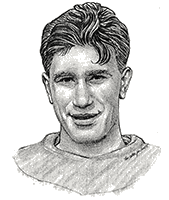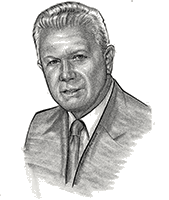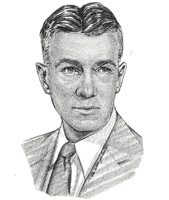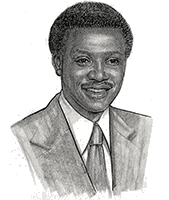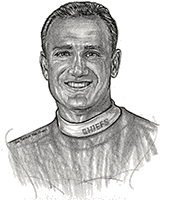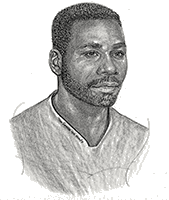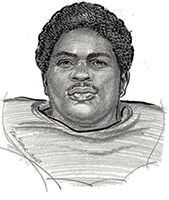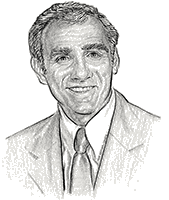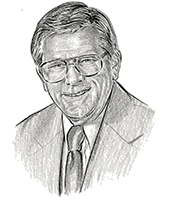Quarterbacked the New York Giants from 1929-1931, leading the teams to second place finishes in first two seasons. Giants owner Tim Mara purchased the entire Detroit Wolverines team in order to secure Friedman’s services. Was All-American quarterback at University of Michigan and part of the famed “Benny to Bennie (Oosterbaan)” passing combination there. Considered the greatest football player ever to play for Cleveland Glenville High School.
Captained the 1924 St. Ignatius High School football team which defeated Cathedral Latin for the City Championship, winning All-Scholastic honors as a fullback and linebacker. Went to college at John Carroll University where he played four seasons as a fullback on offense and linebacker on defense, twice winning All-Ohio fullback laurels. Inducted into the JCU Football Hall of Fame in 1975.
An All-Scholastic and All-Senate back who captained the 1923 West Tech High team to an undefeated and unscored upon season and its first Senate championship, Barclay Sanders went on to Ashland College where he started as a freshman in 1926 and was elected president of the Varsity Club. Later played for Baldwin-Wallace College, earning All Big-4 and All-Ohio honors in 1932 and again in 1933, although an injury ended the latter season for him after four games. Elected to the B-W Hall of Fame in 1978.
Inducted into the Pro Football Hall of Fame in his first year of eligibility in 1983 following a brilliant career as a wide receiver with the Cleveland Browns from 1964-69 and again in 1976-77 and an interim stint with the two-time Super Bowl Champion Miami Dolphins. Compiled career totals of 427 receptions, 85 touchdowns and 8,565 yards gained. His career average of 20.1 yards gained per catch set an NFL record as did his feat of averaging over 20 yards per catch for seven consecutive seasons.
It was apparent soon after Elvis Grbac arrived at St. Joseph High School that the storied athletic power on the shores of Lake Erie had landed another special talent. The sturdy 6-5 youngster made his first impact in basketball, then added football to his resume in his junior year in 1987. Although playing in a run-oriented offense featuring a remarkable talent named Desmond Howard, he attracted enough attention on the gridiron to earn honorable mention All-Ohio honors and a decade later would become the first Viking athlete to be honored by having his numbers retired in two sports- #12 in football and #53 in basketball. Originally interested in continuing his football career at Ohio State, he changed his mind when the Buckeyes fired Head Coach Earl Bruce and opted instead to join teammate Howard at Michigan. As a four-year starter for the Wolverines, Grbac led them to four Big 10 titles, leading the conference in passing in 1990, 1991 and 1992 while setting nine Michigan passing records. Drafted by the San Francisco 49ers in 1994, he served as the backup to Steve Young on a Super Bowl championship team in his rookie season. Elvis went on to play seven more seasons, starting 69 of the 106 games he played for San Francisco (1994-96), Kansas City (1997-2000) and Baltimore (2001). He currently makes his home in Chagrin Falls.
As a 6-6 250 pound defensive lineman, NFL scouts would probably toss him back into the deep end of the talent pool today. But when Al Baker came out of Colorado State University as a two-time all-conference choice in both football and basketball, the Detroit Lions were only too happy to reel him in as their No. 2 pick, the 40th choice overall in the 1978 draft. He repaid their confidence with a spectacular inaugural season, leading the NFL with 23 quarterback sacks, (the first of five consecutive years he would top the league in that category), and earning Defensive Rookie of the Year, Lineman of the Year, and first team All-Pro laurels. Two more All-Pro seasons would follow during his five years with the Lions. Traded by Detroit to St. Louis, he spent four season with the Cardinals, then was traded to Cleveland in 1987, left to join the Minnesota Vikings in 1988 and returned to the Browns for the 1989 and 1990 seasons. During his 13-year pro career, he was credited with 148.5 sacks and in 2004 he was picked by Sports Illustrated as the ninth Greatest Pass Rusher in NFL history. When he retired after the 1990 season, the Florida native and one-time New Jersey high school star elected to remain in Cleveland, stressing an affinity for the area and its residents. He settled in Avon where he owns and operates Bubba Q’s Restaurant and Catering. The restaurant won several “Best in Cleveland” awards and has also developed a reputation for feeding the homeless. He and his wife Sabrina are the parents of two children, Brittany Bo and James Landon.
A native Clevelander who starred at John Hay High, John Hicks went on to a stunning college football career at Ohio State and a highly successful professional stint. He started three Rose Bowl games for OSU at offensive tackle, was named All-Big Ten and a Walter Camp All-American as a junior in 1972, then capped an awesome senior year by repeating those honors and adding Kodak All-American laurels, winning college football’s Outland (best interior lineman) and Lombardi (best lineman) Awards. He finished as runner-up for the Heisman Trophy in 1973 and was honored as the Sporting News College Player of the Year. Joining the NFL’s New York Giants in 1974, he was NFC Rookie of the Year that winter and NFL Man of the Year in 1975 as well as being named All-Pro in both of those seasons. John also played for Pittsburgh’s Super Bowl championship teams in 1978 and 1979 before retiring.
Deceased 2016
A seventh round draft choice of the Cleveland Browns while only a junior at the University of Mississippi in 1957, Gene Hickerson joined the team in 1958 to launch a 16-year career which earned him acclaim as one of the finest blocking guards in the history of professional football. Started his pro career as one of Paul Brown’s storied messenger guards, he later switched to right guard where he played for a decade. Gene led the interference for future Hall of Fame running backs Jim Brown (for the last eight seasons of Brown’s nine-year career) and Leroy Kelly. Beginning in 1963, he was named to five consecutive all-NFL and six Pro Bowl teams and was a key member of the Browns 1964 NFL championship team. After retiring in 1973, the native of Trenton, Tennessee remained in Cleveland as a sales representative and restaurateur.
Deceased 2008
It seemed that Sam Rutigliano never met a person he didn’t like. And if he ever did, it’s likely he still found time to talk to them. Unlike too many of the football coaches at this time, Rutigliano was as outgoing and gregarious as any coach the Cleveland Browns have ever had during his tenure as head coach from 1978 to 1984. While his Cleveland coaching ledger might show a 47-50 record, the entire North Coast is forever linked with Rutigliano’s 1980 Kardiac Kids team. The silence was deafening on that bitter Sunday after Red Right 88 wound up as the heartbreaking interception that ended the Cleveland season, but Rutigliano has done more than his share to put the game and life in perspective since then. When the NFL was drifting into society’s infatuation with cocaine in the 1980’s, Rutigliano made his most important off-the-field call by establishing the team’s anonymous support group, the Inner Circle. It remains more important to Sam than any win or loss. The native of Brooklyn N.Y., whose East Coast accent has become familiar in these parts, put together a football resume that included playing college football at Tennessee and Tulsa, high school in New York. college coaching at Connecticut, Maryland and Tennessee, and NFL positions with Denver, New England, the New York Jets and New Orleans before taking the Browns head coaching job. After doing some broadcasting work, he was served as the head coach at Liberty University for 11 seasons until 1999. Now we see and hear him on local radio and television shows as he dissects the home team. It would have been nice to get one more win at the end of that long ago special season, but Rutigliano has shown himself to be a special winner when it comes to the courageous matters in life.
You have seen Bobby Brown hundreds of times over the years. But you never noticed him, and that’s just how he liked it. Involved in basketball and football officiating for half century, all Brown wanted everyone to know was that the call on the floor or field was the right one. It nearly always was just that. After attending Rhodes High, Baldwin Wallace College and a Captain’s tour with the U.S. Army Air Corps in World War II, Brown settled down with his wife Dorothy in Parma. He began officiating basketball and football games in 1948 and never stopped. He spent 33 years working football games, 24 at the collegiate level. He was president of the International Association of Approved Basketball Officials-Board No. 55 in 1959-60. Besides 25 sectional, 23 district and 18 regional high school tournaments, he refereed three state football championships. In Cleveland, he officiated 14 city championship basketball games and 12 football title games. He has been a high school basketball rules interpreter and spent 24 seasons as an observer for the Ohio Athletic Conference football officials and 24 as Cleveland State’s basketball observer. Somehow he found time to serve terms as the Parma School Board President in the 1960’s and head the Cleveland Touchdown Club in the 1980’s. Numerous awards have come Brown’s way over the years for his steadfast dedication and unassuming dignity. At age 90, he adds this latest honor in his typical humble fashion. It’s the right call once again.
Deceased.
2001 Crocker Rd., Ste. 510, Westlake, OH 44145
Phone: 216-241-1919

